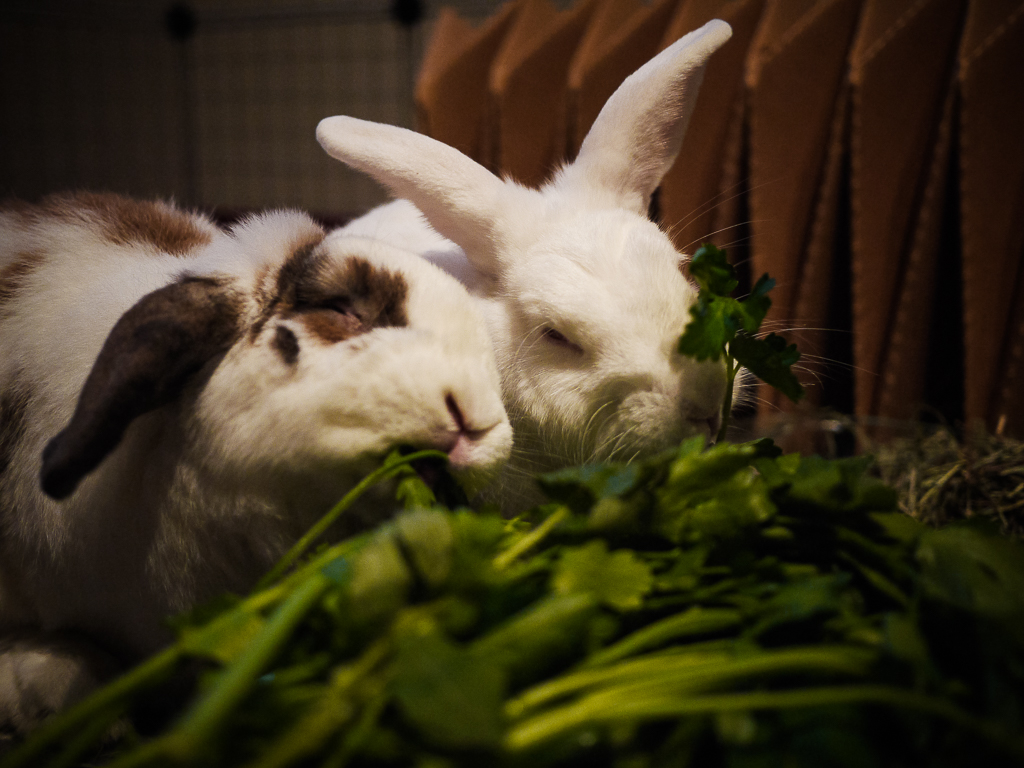Although no direct scientific link between dietary calcium and an excess amount of calcium excreted in the urine has been proven, many veterinarians are advising clients whose rabbits have urinary/bladder problems to decrease the amount of calcium in their rabbit’s diet.
Calcium is an important mineral for bone growth and maintenance, nerve and muscle function, and blood clotting. However the minimum daily requirement for calcium of a medium sized rabbit is about 510 milligrams. This amount of calcium is contained in less than two ounces of commercial pellets or 1 cup of turnip greens. The percentage of calcium in alfalfa and clover hay is 2-5 X the amount needed for an adult nonbreeding rabbit. Grass hays have a much lower amount of calcium, less than half the amount found in alfalfa and clover hay. Commercial pellets provides more than enough calcium for the average house rabbit and could cause a persistently elevated (“high normal”) level of calcium in the blood. If the amount of calcium excreted in the urine becomes too high, problems may develop.1
Calcium metabolism appears to be less complex in rabbits than in many mammals. For rabbits choosing a lower calcium diet can be as simple as knowing the amount of calcium contained in each food item to determine if it should be restricted or eliminated.
Alfalfa hay is extremely high in calcium and should be replaced with lower cal-cium hays such as timothy or oat hay. Fruits are low in calcium but high in sugar and should make up a very small part of the diet. Root vegetables such as carrots and radishes are low in calcium. Most greens are comparatively high in calcium but they are also a very important component of a healthy rabbit diet and should not be eliminated. Broccoli flowers and stem, cilantro, dark leaf lettuce, watercress, Brussels sprouts, celery leaves, cabbage, and endive are good choices when trying to reduce dietary calcium. Turnip greens, broccoli leaves, mustard greens, kale, and collards greens should be restricted or eliminated depending on the severity of the problem. *
Reference
1. Summary of Calcium in Rabbits, John E. Harkness (Rabbit Health News, 1994: Vol.11, p.7)
Calcium Content of Raw Vegetables
| 6 mg | Peppers, sweet |
| 10 mg | Alfalfa sprouts |
| 15 mg | Pumpkin leaves |
| 16 mg | Coriander (cilantro) |
| 18 mg | Chard, Swiss |
| 19 mg | Radish seed sprouts |
| 20 mg | Lettuce, Romaine (per 100g serving) |
| 20 mg | Squash, zucchini |
| 21 mg | Jerusalem artichoke |
| 24 mg | Pumpkin |
| 26 mg | Endive |
| 26 mg | Squash, summer |
| 28 mg | Asparagus |
| 28 mg | Cauliflower |
| 28 mg | Purslane |
| 28 mg | Radishes |
| 30 mg | Carrots |
| 30 mg | Egglant |
| 32 mg | Arugula |
| 32 mg | Cabbage |
| 32 mg | New Zealand spinach |
| 34 mg | Kohlrabi |
| 38 mg | Lettuce, looseleaf |
| 39 mg | Turnips |
| 40 mg | Cress, garden |
| 40 mg | Watercress |
| 42 mg | Broccoli |
| 44 mg | Celery |
| 46 mg | Beet greens |
| 56 mg | Spinach |
| 58 mg | Mustard greens |
| 59 mg | Dock |
| 62 mg | Peas, edible pod |
| 65 mg | Rutabagas |
| 68 mg | Celeriac |
| 74 mg | Chinese cabbage |
| 78 mg | Parsley |
| 82 mg | Borage |
| 82 mg | Okra |
| 94 mg | Kale |
| 103 mg | Dandelion greens |
| 105 mg | Turnip greens |
| 137 mg | Kale, Scotch |
| 180 mg | Chicory greens |
| 218 mg | Collards |
| 309 mg | Lambsquarter |
| 315 mg | Mustard spinach |
per 1 cup serving, unless otherwise noted
Sources United States Department of Agriculture, Human Nutrition Information Service, Agriculture Handbook Number 8-11, “Composition of Foods: Vegetables and Vegetable Products.” Revised August 1984. These are values representative for vegetables collected from across the country; precise values will vary somewhat between regions.

